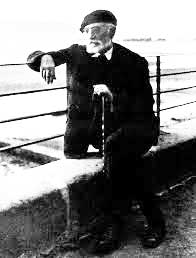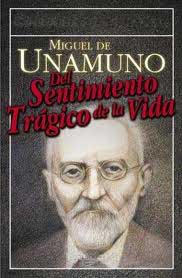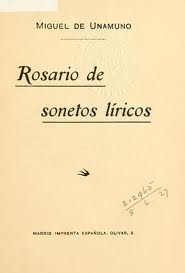Works of Miguel de Unamuno
Apart from using all the genres in his work, Unamuno felt that he had to create the most characteristic works of his time every time he wrote something new. Thus, his plays had to be the most adequate dramatic expression of his period; his nivolas a superior genre to the regular novels; his poetry was at an advantage over that of his contemporaries; and his essays were as personal and elevated as possible.
Miguel de Unamuno - Works

For years, Unamuno was considered only an essayist, because his poems weren't recognized or valued by his contemporaries, even if Ruben Dario considered him a more than acceptable poet. The same happened with his narrative works: Unamuno surpassed his works with his distinctive and brilliant personality, and his works have to be considered under the same light. His nivolas are novels, but with a very innovative and unique style which can't be reproduced.
In his style, Unamuno bases his works on the spoken language, and rejects rhetoric. He has a rich and complex syntax, with a vocabulary that mixes everyday words with more educated ones. Ortega y Gasset argued his particular style came from the fact that his mother tongue wasn't Spanish (Castilian) but Basque, and he'd had to learn Spanish, so his use of words was not as transparent as that from a true Spanish speaker.
Essays
Miguel de Unamuno was an excellent essays, and there are some topics that he touched frequently in these works: philosophy, political ideas, the correct use of Spanish (discussing with Unamuno would have been a great way to learn Spanish), and "the Spanish problem".

Like the rest of his works, Unamuno's essays didn't follow a pre-established plan, but rather flowed naturally. He often used contradictions and paradoxes to give strength to his arguments. His philosophical essays revolve about the human preoccupation for existence, the meaning of life, and the uncertainty about the individual fate after death. His better known works on this area are "Tres ensayos" (1900), "Del sentimiento trágico de la vida" (1913) and "La agonía del Cristianismo" (1931).
Politically, Unamuno was a liberal, but not in the strict sense of the word. He was profoundly affected by the crisis that liberalism went through during the 19th century. His ideas revolve around the "religion of freedom" point of view. He though that just because life was only a temporary thing, since we're all destined to die, progress didn't make any sense. This contradicts his views towards communism and the Russian Revolution of 1917, but his reason lies in the religious and mystical undercurrent that he thought moved the Russian revolutionaries. Being a man of deep faith, he also rejected any kind of anticlericalism.
Poetry
For Unamuno, art was a way of expressing the uneasiness of the soul. His poetry covers more or less the same topics as the rest of his works: spiritual anxiety and the pain over God's silence, and time and death. He always felt an attraction towards the traditional metrics, and though in his first poems he eliminates the rhymes, he does use them in later works.

The best examples of his poetry are: "Poesías "(1907), "Rosario de sonetos líricos" (1911), "El Cristo de Velázquez" (1920), "Andanzas y visiones españolas" (1922), "Rimas de dentro" (1923), "Teresa. Rimas de un poeta desconocido" (1924), "De Fuerteventura a París" (1925), "Romancero del destierro" (1928) and "Cancionero" (1953).
His verses were never harmonious or the product of hard work. His stanzas are short and very personal, and he barely spent any time revising his work and polishing it. He rejected the traditional forms and opted to write in his own personal way, shying away from the style established by his peers.
Narrative
Unamuno cultivated the narrative genre insistently. However, because he didn't like to adapt himself to the already established rules for novels and other genres, he decided to bypass them all and invented his own genre, the nivola. The characteristics of his narrative are:
- Naked narrative: with barely any descriptions, so that the readers can imprint their own fantasies in his stories. They are normally set in the beginning of the 19th century in Spain.
- Only one main character, who fights through his own existential doubts.
- The main "problem" in all his novels is the necessity that humans feel towards being, and the fear of "not being".
- Novels as a way of acquiring knowledge, exceeding the level of anthropology and delving into the ontological and the different possible perspectives.
- Reinterpretation of the realism concept: repeating characters from one book to another, mixing of real characters with fictional ones.
- Dialogue as the most important part of narrative.
- Open structure: possibility of different readings for the same novel, forcing the reader to take part intellectually.
- Anticipation of many of the characteristics of the contemporary novel.
His most important narrative works are "Amor y pedagogía" (1902), "Niebla" (1914) and "La tía Tula" (1921).
Theatre
The dramatic works of Unamuno never had much success because of the heavy philosophical topics he normally tackled. The characteristics are:
- Schematic: he only writes about the interactions and passions of the characters.
- The scenery is almost bare, as simple as possible.
- The most important thing is knowing what's going on inside the characters, their feelings and emotions.
Some of his dramatic works are: "La esfinge" (1898), "El pasado que vuelve" (1910) or "Sombras de sueño" (1926)
However recognized (or not) the works of Unamuno were while he was alive, today he's considered one of the most important writers of the Spanish literature, and his numerous posts in the University of Salamanca confirm the brilliancy os his mind.

